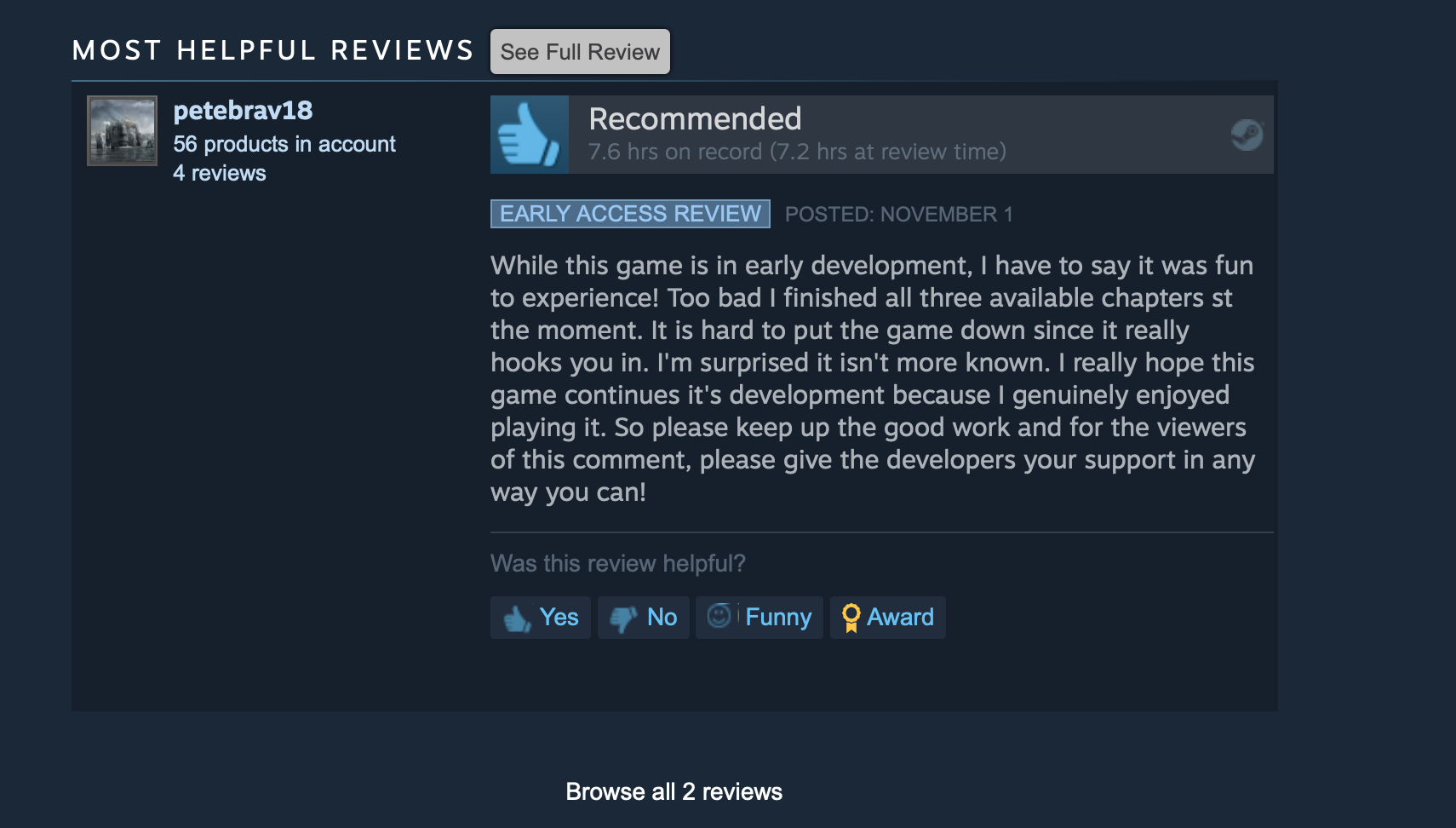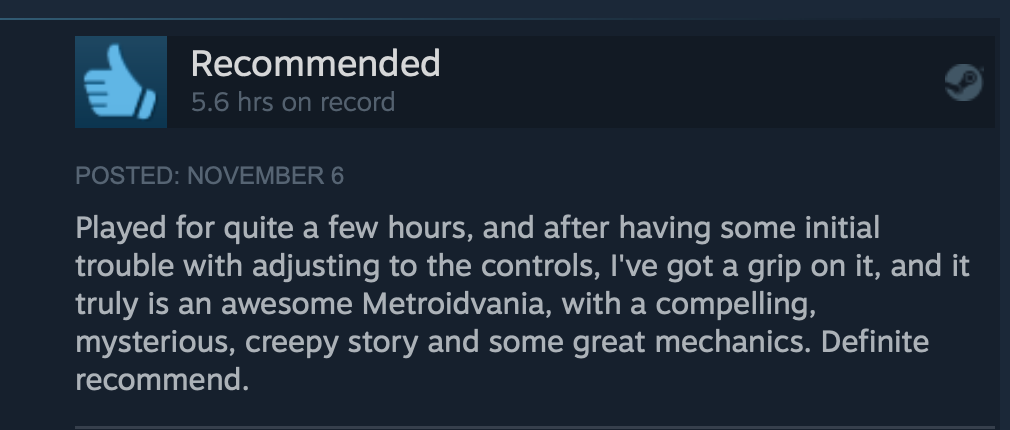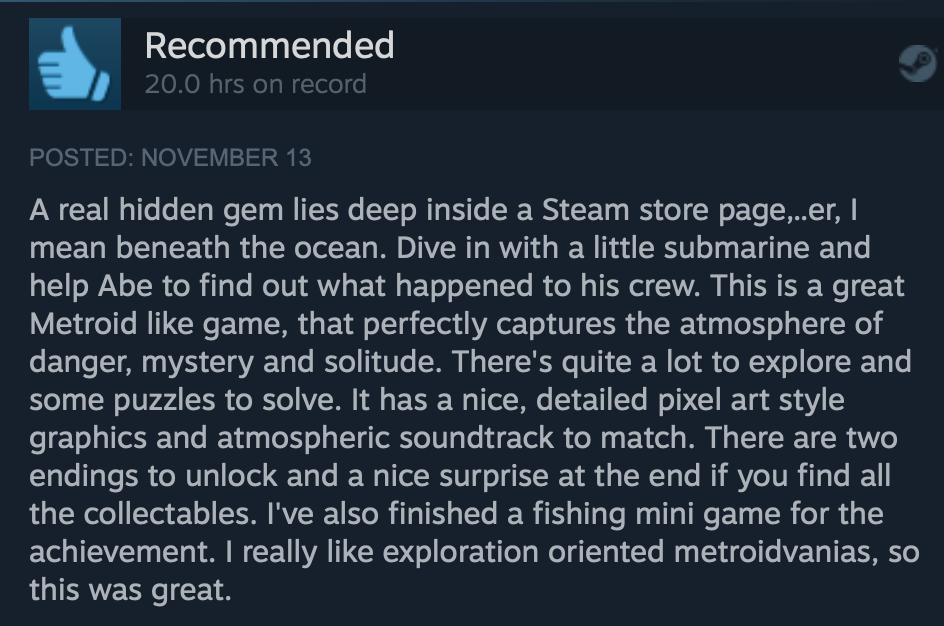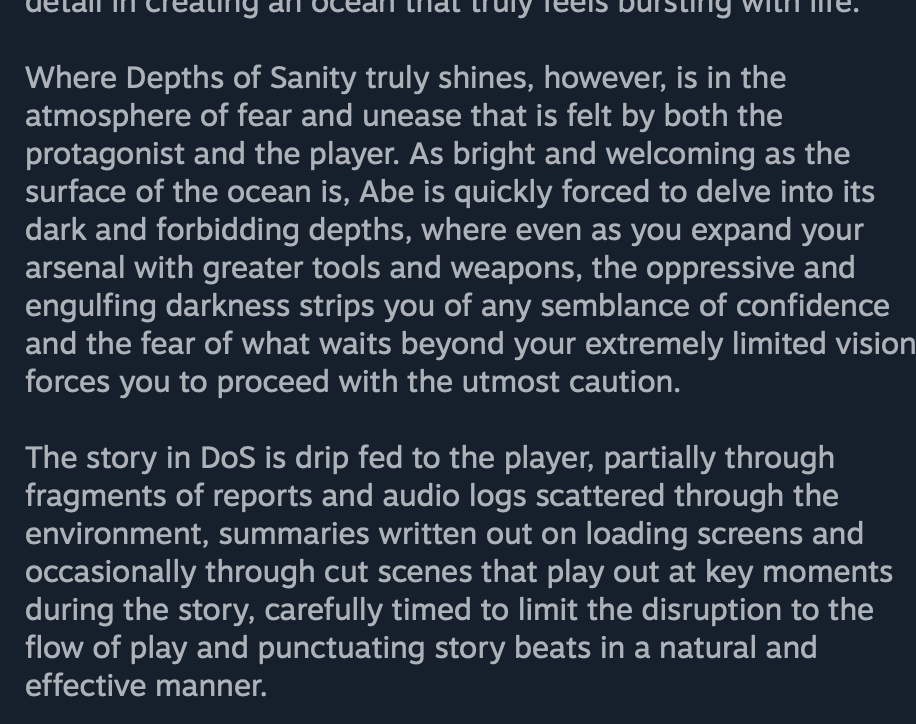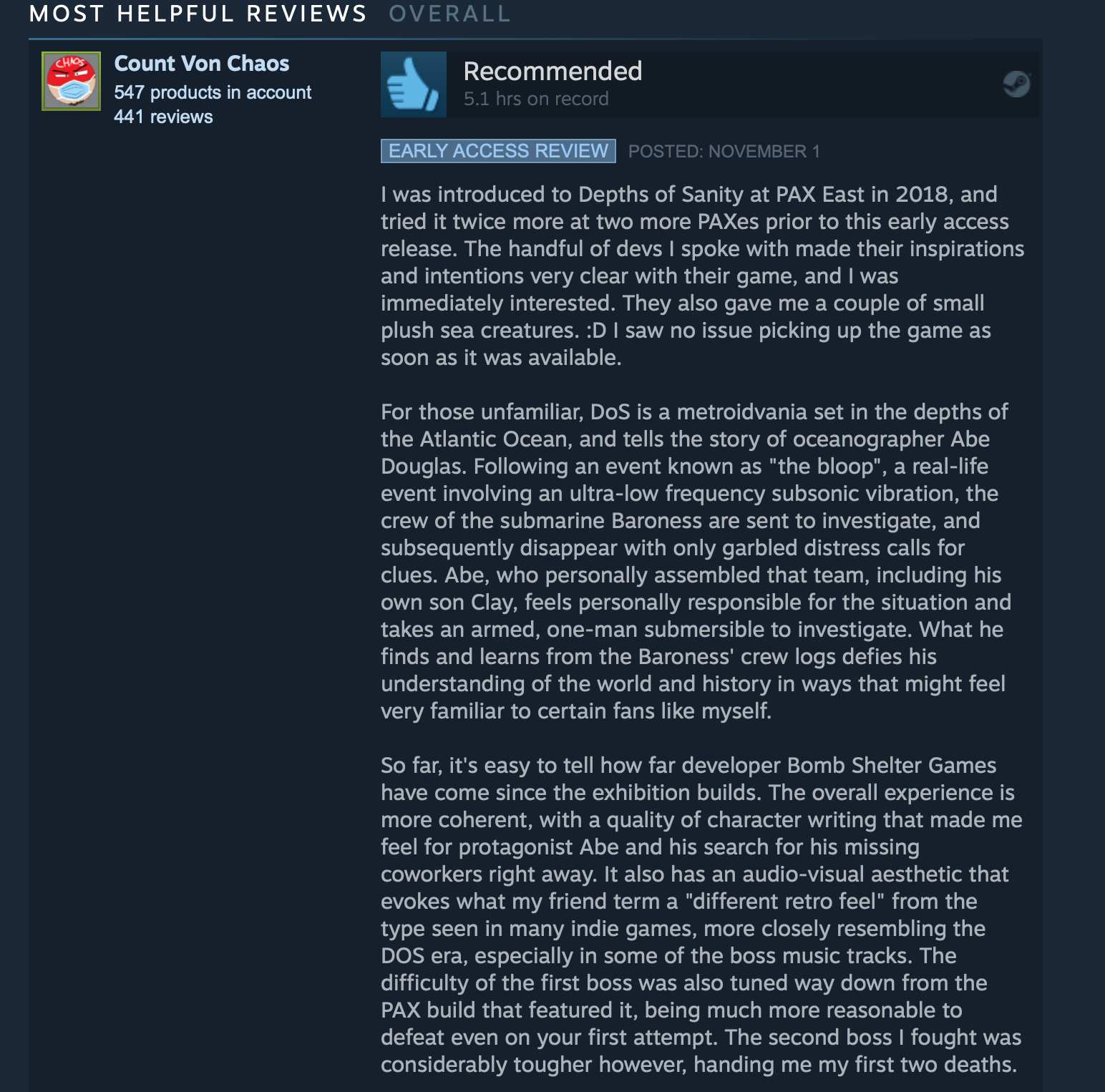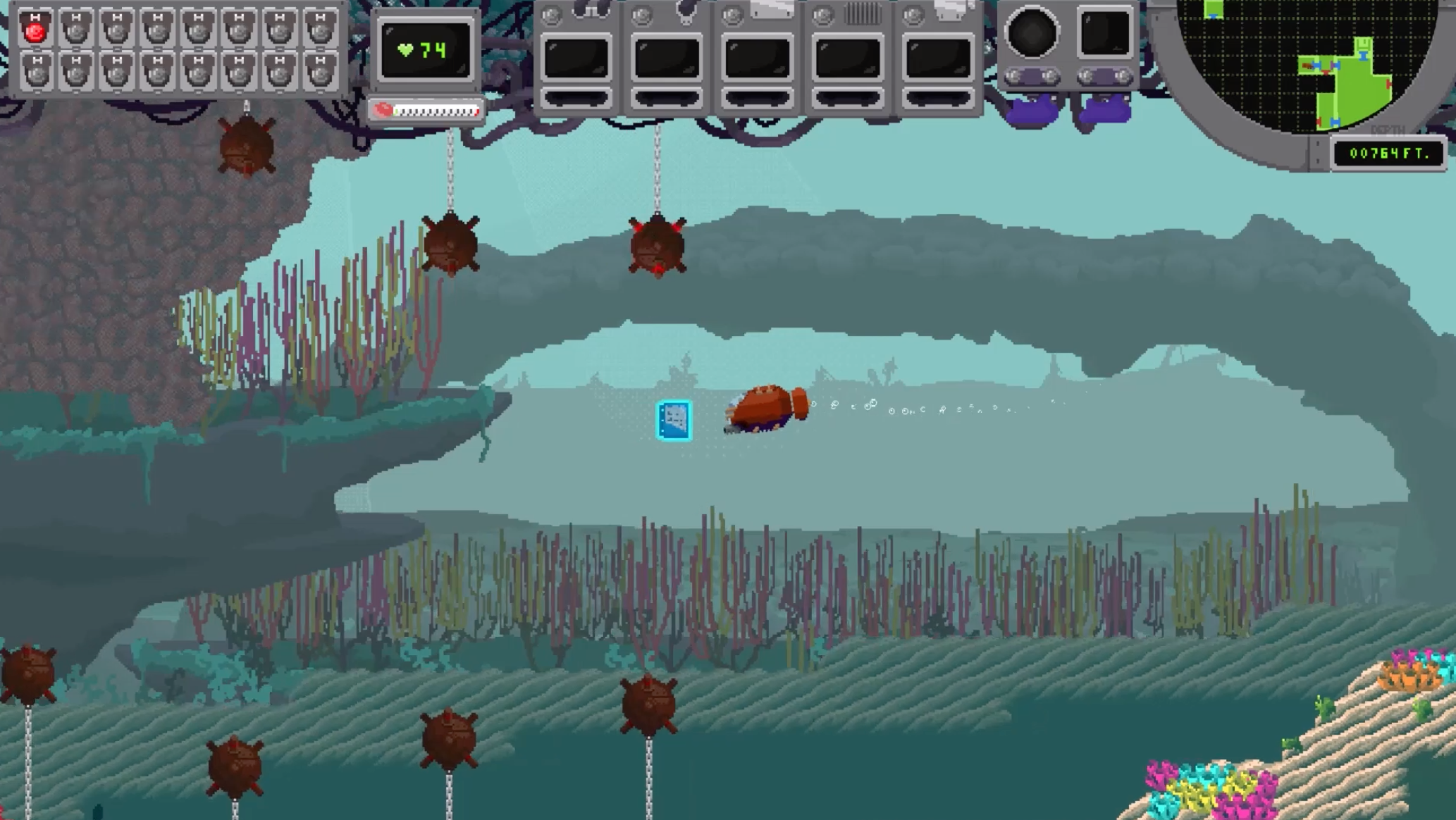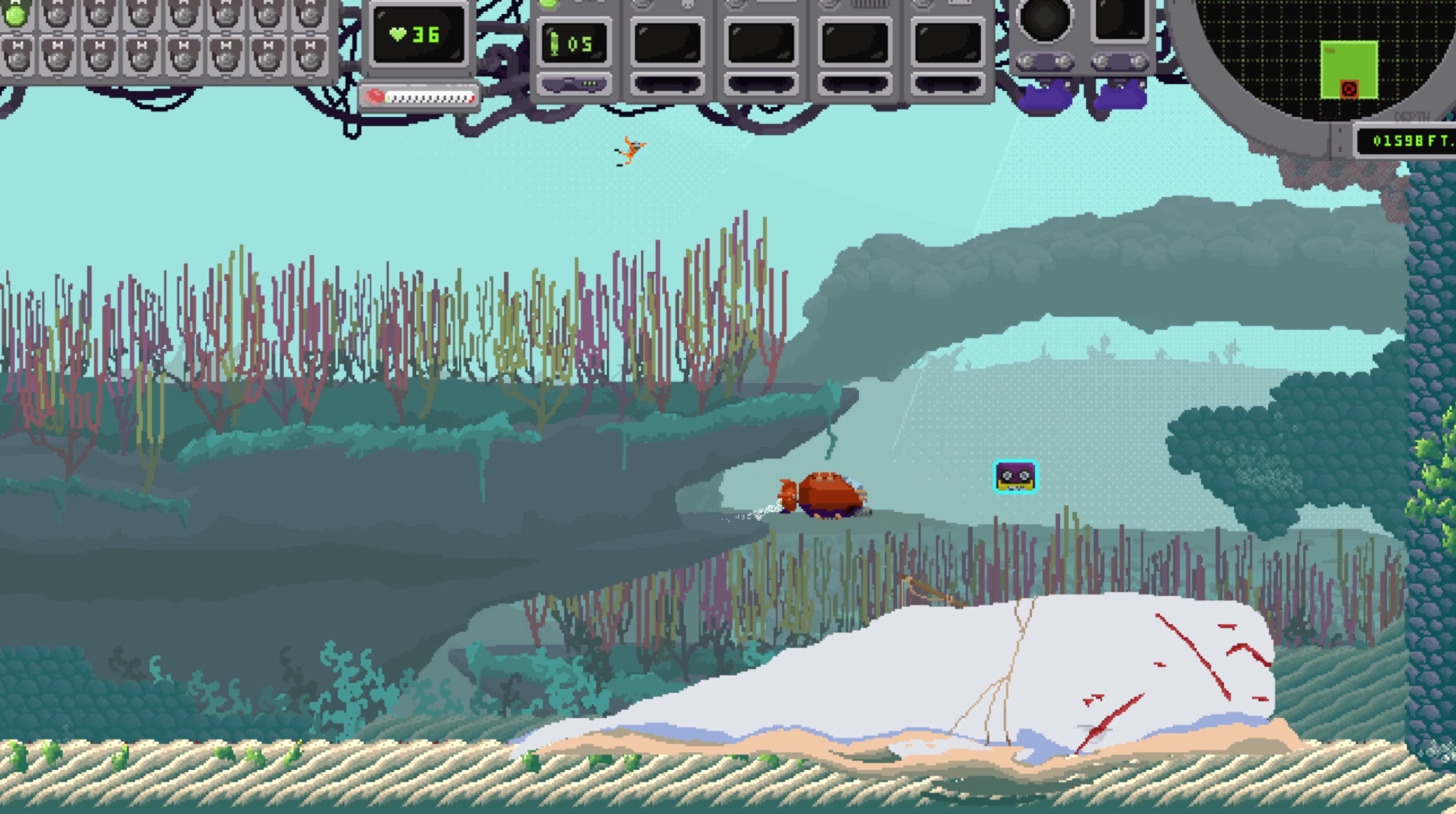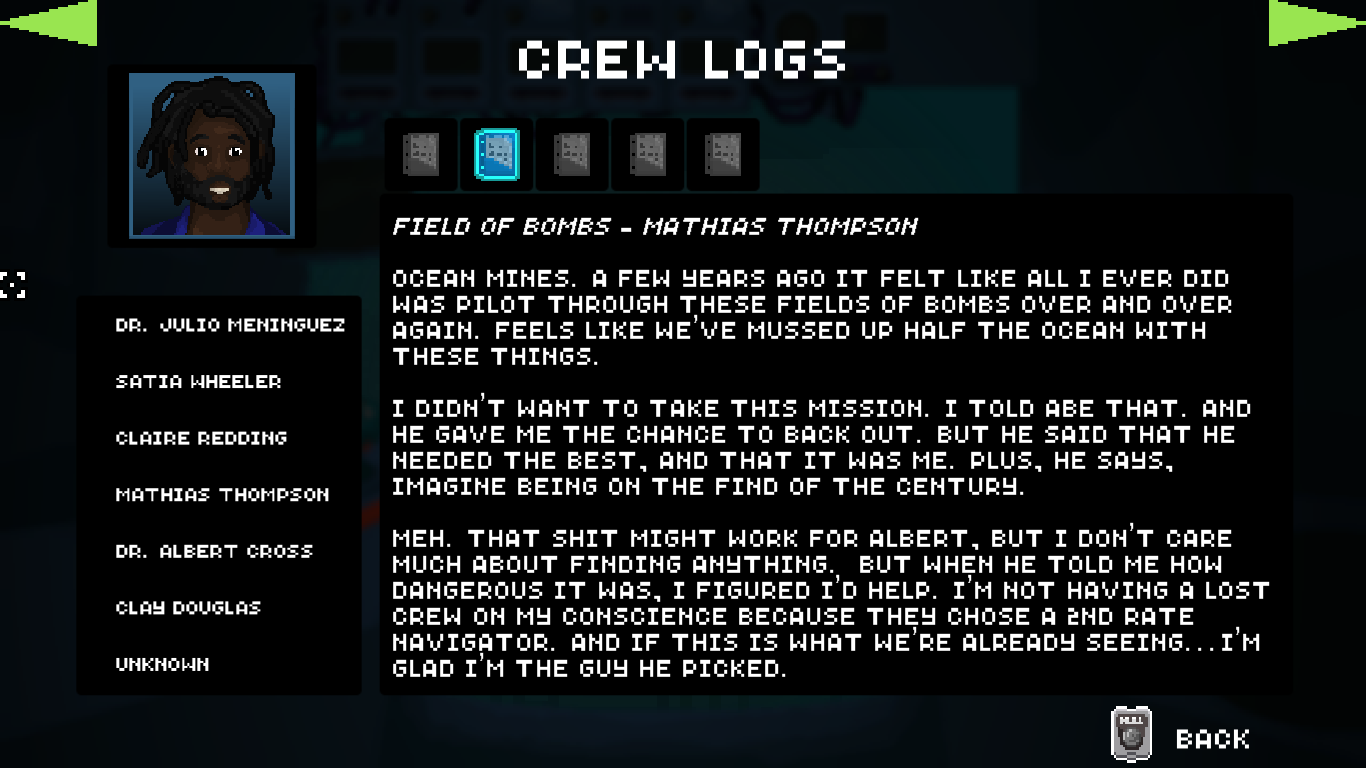Depths of Sanity
PROJECT OVERVIEW
In June of 2019, I was hired to work on one of the most interesting projects I’d ever been a part of—writing the story for the upcoming indie-game “Depths of Sanity”. The game had been in development for a few years, and while they had the setup of the story and a few key moments, it was officially time to turn those ideas into an honest-to-goodness narrative.
This was a pretty interesting challenge, since I would be crafting a story around several unalterable plot beats, environments, and bosses that had already been put into the game. My job was to create the narrative throughline for the whole experience—creating not only the full outline and script, but fleshing out the world with collectibles, notes, and all sorts of touches, eventually even tackling a majority of their marketing materials and becoming a major force behind the game on the road to its Steam Early Access launch in October 2020.
Here’s how it happened:
Step 1: Outlining The Story
Before we go further, let me tell you about the game’s basic premise:
In 1997, the G.O.A.A. (Global Oceanic & Atmosphere Administration) records an ultra-low frequency vibration at the bottom of the ocean, big enough that it registers in every major body of water across the planet. They call it The Bloop ( this is real by the way – you can read about it here) and a submarine crew—The Baroness—is sent down to investigate the cause of the vibration.
They don’t come back.
After two weeks of radio silence, the G.O.A.A. picks up a garbled distress call from their vessel. Abe Douglas, the Commander who assembled the vessel’s crew, makes it his responsibility to find them and bring them home. The game starts with Abe waking up in the medical bay in the G.O.A.A., weeks after his mission, with a psychiatrist trying to figure out what happened to him while he was out at the sea. Each level of the game him telling the psychiatrist more of what happened to him on the trip.
This setup—along with the environments, two story beats, and the game’s bosses—were unalterable. However, there was LOTS of room to tell very different stories between them, especially because the team had never actually decided what the mystery would turn out to be.
To get a grip on the overall story, I first created several different outlines that utilized the pieces that already existed, each one taking the narrative in a different direction. I also talked a lot with the team to align on a few guiding principles for the drafts, like how we wanted a darker story with psychological themes and Lovecraftian elements, but we all agreed we didn’t want to use actual Lovecraft mythos (which has recently been done to death in gaming).
Eventually I created three completely different outlines of the plot, one closer to their original idea, one where I redid the story in a way that I preferred ( but would require a few changes to things they’d already implemented), and one that went totally bonkers to show them different possibilities of what we could do. In the end, everyone agreed that the 2nd version was the best story (I would be lying if I said I didn’t fist bump hard after that meeting lol).
Step 2: Breaking the Main Story vs. Side Story
Depths of Sanity is a “metroidvania” game, and it’s important that you know a little bit about what a “metroidvania” is to understand some of the tropes and conventions I had to work within. It’s a catch-all term used to describe a genre of game with a particular structure—one that usually involves the player traversing environments multiple times, unlocking new pathways and portions of the world as their arsenal of tools grows. They also generally have a significant amount of hidden/optional areas to explore, alongside multiple endings that are usually dependent on what you uncover across your journey.
This led to my first big challenge: deciding what would be a part of the “main story”, and what would be withheld as “side stories” and optional content. To tackle this, I blew out the outline of the story from 8 pages to 25, and then took all of the beats that the player, absolutely, positively had to experience in order to understand the story and marked them as main plot points. Anything that didn’t fall into that category became a candidate for optional content, some of which would be necessary to uncover in order to achieve a better ending for Abe and (some) of the crew by the end of the game.
Most of the side content would revolve around learning more about the crew of the Baroness, with the fate of at least one crew member left completely out of the main narrative to only be uncovered by thorough side exploration.
That led to the next big story portion to tackle…
From the top left: Mathias Thompson, Dr. Albert Cross, Clay Douglas, Claire Redding, Dr. Julio Meninguez, and Satia Wheeler
Step 3: Crafting Side Characters
One of the biggest holes that needed to be filled was just who the crew of the Baroness were. A lot of the side content would involve getting to know them deeply, but in the game’s original design document they were only sketched out by their name and role on the ship.
This was definitely one of the most fun things for me to elaborate on, as I had to create six distinct characters that would stay memorable when none of them would actually have voice-acting, and they each needed an arc and a purpose that played into the overall narrative. Some of this was helped by a conceit in the main story that would help bring a lot of their more interesting characteristics to the surface.
SEMI-SPOILER WARNING: The antagonist of Depths of Sanity causes the characters to hallucinate in an effort to get inside their heads, often showing you one of your happiest memories, or a dead loved one back and alive, or a wish you may have had for things to go different in the past. It then promises you an eternal existence with this memory/moment if you let it feed.
This forced me to make sure that my characters had very well fleshed-out backstories. I wrote full, multi-page treatments of who each character was, their past, some of their highest highs and lowest lows, and then slowly broke those out into different kinds of documents that you could come across throughout the game, some of which made the main story, but much of it side-content.
Step 4: Writing the Main Script
The main script took a few drafts to crack, but it wasn’t too difficult. It came to 76 pages, with two distinct endings. There were a couple of interesting restrictions I had to keep in mind while writing it: For one thing, the team really didn’t want to stop the player’s momentum very often during gameplay, which meant that most of the cutscenes would occur between levels, utilizing the psychiatrist heavily (and saving us quite a bit in added drawing/animation needs).
For scenes that would occur in the ocean, I created a two-prong system to help us work around stopping the player: “Audio Logs” and “Notes”. These were internal ways of viewing them (especially because there was no voice acting, hence no actual “audio logs”) but they had completely different use-cases in gameplay.
Notes were generally received for optional flavor text. If you picked one up, the game would ask you if you wanted to read it now or ignore it until later. Audio Logs, which are distinctly different looking, immediately play a cutscene upon being picked up, using the game’s dialogue-box system. This helped solved the issue of interrupting the player’s gameplay too much while still allowing me to tell the important beats of the story.
Notes are on the left, the audio logs on the right. If you choose to read a note, it appears in your menu, while audio logs just start playing in the dialogue box.
Notes would be placed in out-of-the-way, optional areas, while Audio Logs would be on the main path. And because the player triggered them, it didn’t have the same feeling as constantly stopping the player for a cutscene because they initiated it. You could see in testing that people would see an Audio Log, maybe leave it while they explored a whole room/series of rooms, and then come back to it when they were ready to view it. Very rarely would a player skip them, because I made sure that the vast majority of them conveyed important story information, which players understood within the first hour.
Why have I been talking about this so much? Because that 76-page script was only 25% of the story. The rest of it was…
Step 5: Creating Notes, Logs, and Optional Content
The bulk of the writing on the game actually occurred in the optional notes, logs, and story moments that would occur off-the-beaten path for players who really took the time to explore the game. This was definitely the most difficult part of the writing process, and it forced me to create an master narrative excel document with all of the plot beats, level events, and more in order to figure out where different notes and items needed to be placed in the overall story for players to discover.
I wound up writing dozens of logs for each character, eventually pairing them down to the most interesting and essential to make it into the game, while still leaving others in case there was an issue where more narrative needed to be added, or if a section felt too isolating where we didn’t want it to be.
The amount of writing in these added an additional 60 pages of scripting to the game, and that was before we dealt with other writing intensive projects (weapon and enemy descriptions, item breakdowns, etc.) which added even more on top of it.
Step 6: Implementation and Testing
As the story got implemented, I became the main tester of all of the story content, playing through segments over and over again to ensure that the story was being delivered correctly, and dealing with any bugs that were interfering with it.
In the beginning, there were plenty of bugs—the camera system not working and focusing on the wrong element of a cutscenes, the wrong cutscene playing at the wrong area, notes not quite working, dialogue getting cut off, and more. There was lots and lots of tune-up work in the lead-up to Early Access to make sure everything that needed to come across did, with occasional art fixes as needed to help sell different elements better.
Step 7: Early Access Launch
After working on the project for a little over a year, we launched Depths of Sanity in Steam Early Access on October 30th, 2020. The early access version of the game contained the first 3 (out of 6 chapters) playable in their entirety. The plan had not originally been to release like this, but due to 2020 destroying nearly every event we had to get player feedback and testing, this was the best route for us to start getting the important criticism we needed to take the game into the next level for full launch.
So instead of waiting and launching it simultaneously on all platforms, we would launch in Steam Early Access with the first half of the game, releasing additional chapters every 2 months while incorporating player feedback and criticism, and then launching on Steam first, with other platforms following after.
We had no idea what would happen (most people interested in the game were interested in the full version, and in particular, many who signed up for updates owned a Nintendo Switch). Luckily, we had several hundred players buy the game and start giving us feedback dramatically improved the adventure, and each chapter released was considered better than the ones before it.
FULL LAUNCH AND RESULTS:
After two years (!) in Early Access reworking the game, Depths of Sanity officially released on Nov 2, 2022.
